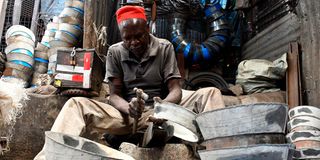Dim outlook as key sectors hit by budget shortfalls

A jua kali artisan, who specialises in making jikos, at work at his workshop on Landhies Road in Nairobi on May 11, 2022.
President William Ruto’s promise to turn around the economy faces a huge test as key sectors propped as drivers of his ambitious economic transformation agenda suffer low budgets, throwing millions of Kenyans who may have banked on his word into a spin.
The President has insisted that growing local production, supporting Micro, Small and Medium-sized Enterprises (MSMEs) and general improvement of the country’s business environment will fuel his administration’s pursuit of economic transformation.
But, while in speeches the President may have painted the picture of an economy teeming with potential and just ready to boom with his government’s support, in action, his government has starved the sectors that are expected to drive the growth.
At least eight sub-sectors classified under the General Economic and Commercial Affairs (Geca) will suffer a Sh90 billion budget shortfall in the next financial year — the first budget under President Ruto.
Sub-sectors affected
The sub-sectors, which include Cooperatives, Trade, MSMEs, Development Industry, Investment Promotion, Tourism, East African Community (EAC) and Arid and Semi-arid Lands (Asals), report a cumulative budget requirement of Sh136.7 billion but have only been allocated Sh47 billion in 2023/24.
The MSME sub-sector, for instance, which the President has spoken heavily about before and after the election, painting it as one that has historically been neglected despite its huge potential, is planned to suffer a 78 per cent budget shortfall.
During the ongoing 2023/24 budget preparations, the sub-sector indicated that its budget requirements will be Sh58.8 billion, but has been allocated a mere Sh12.9 billion.
Industry, another sub-sector the new government plans to leverage to drive local production and rescue Kenya from the yoke of importation, requires Sh11.8 billion but has only been allocated Sh5.5 billion.
President Ruto’s Treasury further allocated Sh2.26 billion to the Investment Promotion sub-sector, whose input in ensuring that more local and external players put their money into the economy is key for the new government’s agenda, despite its requirement of Sh8.7 billion.

Trans Nation Sacco Society Limited receive the top MSES Taxpayer Northern Region award from President William Ruto as his deputy Rigathi Gachagua (centre), CS Treasury Prof Njuguna Ndung'u and Kenya Revenue Authority (KRA) Commissioner General Githii Mburu look on during the 2022 Taxpayers' Day at the KICC on October 28, 2022.
The Geca sector, during the session of a public hearing for the 2023/24 and the medium-term budget preparations yesterday, indicated that inadequate budgetary funding has continued to affect its operations.
“The Geca sector is inadequately funded resulting in delays and non-completion of planned programmes and projects. The challenge has led to the accumulation of pending bills, penalties and cost overruns,” said Trade Principal Secretary Alfred Ombudo. The Kenya Institute of Public Policy Research and Analysis (Kippra) noted that, while the sector has lined up at least 17 key programmes and projects to undertake over the next three years, underfunding could hinder its operations.
Kippra noted that “Geca sector is key to the realisation of the government development agenda as relates to manufacturing, value addition, food security, MSME and Tourism development.”
Commitment lacking
The institute, whose research the government relies on to shape policy, noted that, while in planning President Ruto’s administration has shown heavy emphasis on supporting MSMEs, Trade and Investment promotion, in budgeting, there is not much commitment.
Kippra observed that the Geca sector has operated on limited budgetary allocations since 2014, which has affected its operation and general economic growth.
Under the 17 planned programmes and projects the sector plans to undertake between 2023/24 and 2025/26, three address MSMEs, Investment and Industrial development is also catered for by three of them and four address issues on trade, including the promotion of exports.
The sector planned to raise Sh97.8 billion in the next development budget from the government, but Treasury has proposed an allocation of only Sh21.5 billion, with loans and grants expected to fund the remaining chunk.
The budget shortfall is not only in the next financial year, where the sector is proposed to get a mere 34 per cent of its resource requirement, but also successive ones where it is planned to get 39 per cent and 44 per cent of its budget requirement in 2024/25 and 2025/26 respectively, according to current estimates.
This is even as the sector puts on a brave face, with its ambitious programmes targeting to grow Kenya’s manufacturing sector, improve the business environment and access to affordable finance and markets by MSMEs, and boost agricultural productivity by enhancing market access and value addition.
Among other challenges players in the sector cited during the public hearings was the current high cost of energy.





